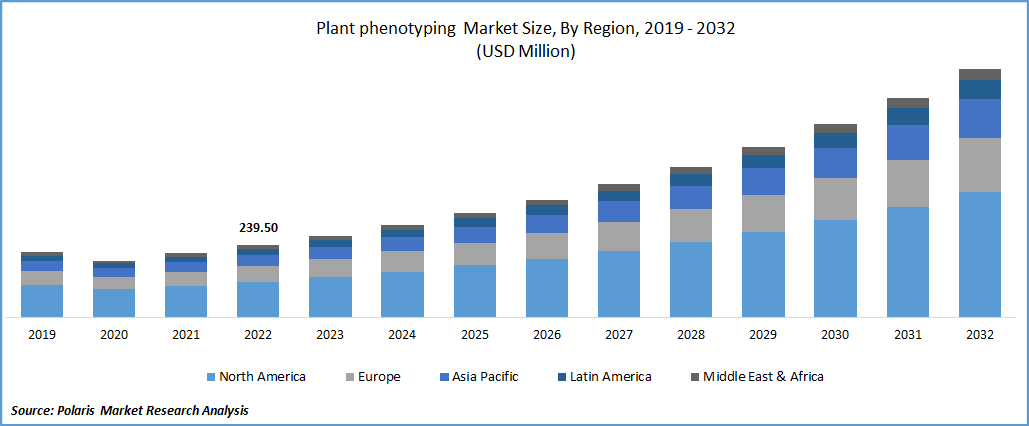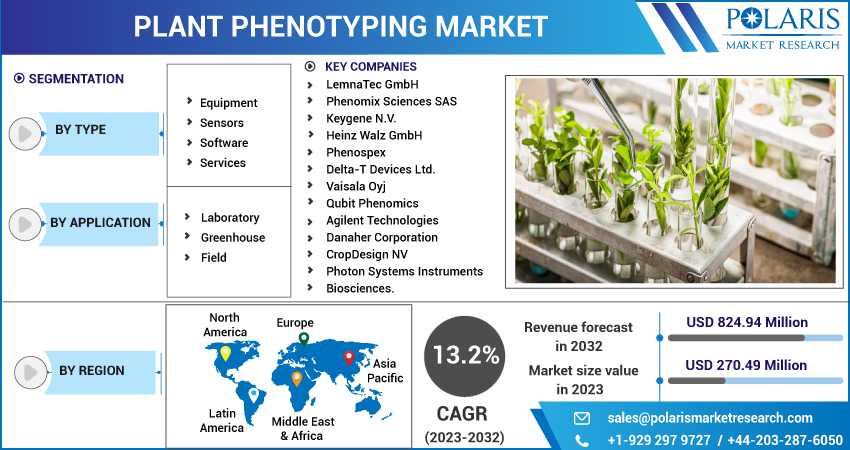
Plant Phenotyping Market Share, Size, Trends, Industry Analysis Report
By Type (Equipment, Sensors, Software, Services); By Application; By Region; Segment Forecast, 2023-2032
- Published Date:Jun-2023
- Pages: 118
- Format: PDF
- Report ID: PM3375
- Base Year: 2022
- Historical Data: 2019-2021
Report Outlook
The global plant phenotyping market was valued at USD 239.50 million in 2022 and is expected to grow at a CAGR of 13.2% during the forecast period. The need for high-yielding crops to ensure food security for a growing global population drives the demand for innovative plant breeding techniques to improve crop productivity. This demand is further fueled by the increasing frequency of extreme weather conditions and global warming, which emphasize the need for crop productivity worldwide and therefore support the market's growth. Furthermore, the primary goal of plant phenotyping is to improve agricultural production and sustainability by identifying plants that have desirable traits such as disease resistance, drought tolerance, and high yields. This information can then be used to develop new plant varieties through breeding and genetic engineering.

To Understand More About this Research: Request a Free Sample Report
Plant phenotyping is an emerging scientific technique that connects genomics with plant agronomy, whereby the phenotype or functional plant body is formed during growth and development through the dynamic interaction between the genetic makeup or genotype and the physical environment in which plants grow.
The plant phenotyping market is growing rapidly due to advancements in technology, such as remote sensing, imaging, and big data analytics, which have significantly enhanced plant phenotyping capabilities. With these tools, it is now possible to measure various plant characteristics quickly and accurately, enabling the analysis of large numbers of plants within a short period.
Moreover, the market is expected to grow in the coming years as the demand for sustainable and efficient agricultural practices continues to increase. The development of new technologies and techniques will also play a crucial role in driving the growth of this industry. The impact of COVID-19 on the market has been mixed, with some negative effects on supply chains and funding and some positive impact on the demand for sustainable agriculture and the adoption of digital technologies.

For Specific Research Requirements, Speak With the Research Analyst
Industry Dynamics
Growth Drivers
The demand for innovative plant breeding techniques to improve crop productivity is driven by the need for high-yielding crops to ensure global food security. In addition, the requirement for crop productivity worldwide due to the increasing frequency of extreme weather conditions and global warming is favoring the plant phenotyping market. Germplasm and seed distribution are common practices in breeding programs, with approximately 90% of the world's food crops grown from widely distributed seeds in national and international trade.
However, seed transmission is an effective method of plant disease dispersal, and many plant pathogens can be transmitted through seeds. Therefore, plant phenotyping techniques are necessary to eliminate and propagate disease-resistant crop varieties to combat the increasing number of seed diseases that affect crop productivity. The demand for plant phenotyping technologies is increasing due to the outbreak of plant diseases in cereals, fruits, & other crops worldwide, which drives the need for disease-resistant crops and improved crop productivity.
Report Segmentation
The market is primarily segmented based on type, application, and region.
|
By Type |
By Application |
By Region |
|
|
|
To Understand the Scope of this Report: Speak to Analyst
Equipment sector is expected to hold a dominant position during forecast period
Equipment is expected to dominate the market during the projected period. Adopting advanced plant phenotyping equipment is a key driver for the growth of the Plant Phenotyping Market. Using sensors, cameras, and imaging devices allows for rapid and precise measurement of plant characteristics, enabling the analysis of large numbers of plants in a short time. Additionally, the availability of software for data analysis and processing further fuels the demand for equipment used in plant phenotyping.
Another growth factor for the Equipment segment is adopting advanced technologies, such as machine learning and artificial intelligence, in plant phenotyping. These technologies enable more efficient and accurate data collection, analysis, and interpretation, leading to improved decision-making in agricultural practices. For instance, in 2021, LemnaTec, a leading plant phenotyping solution provider, launched the Field Scanalyzer, a high-throughput plant phenotyping system designed for field applications. The system allows for non-destructive, automated measurement of plant traits, including plant height, leaf area, and chlorophyll content.
Moreover, government funding for research and development in plant phenotyping is expected to drive demand for equipment in this field. The increasing awareness among farmers about the advantages of using plant phenotyping equipment is also likely to contribute to the market's growth.
Greenhouse dominated the market in 2022
Greenhouse dominated the market in 2022 and is expected to maintain this position throughout the forecast period. The demand for greenhouse applications in the plant phenotyping market is primarily driven by its ability to provide a controlled environment for plant growth, allowing researchers to study plant responses to specific environmental stressors and optimize growth conditions for crop improvement.
Greenhouses also offer year-round research opportunities, irrespective of external weather conditions, so researchers can conduct experiments and collect data throughout the year. Greenhouse applications can also help reduce variability in plant growth and development in open-field conditions. Furthermore, the increasing demand for high-quality food and sustainable agriculture practices drives the need for more efficient and effective plant phenotyping techniques, including greenhouse applications. By studying plant responses to environmental stressors in greenhouse environments, researchers can identify genetic traits important for crop breeding and improvement.
North America garnered largest revenue share in 2022
North America region generated the largest revenue share in 2022. The key reason the market is expected to grow in the coming years is due to well-established agricultural practices, significant investments in research and development, and the adoption of advanced technologies in the agriculture sector. Additionally, the region has a high demand for crop production due to a growing population and increasing food consumption, which has led to the adoption of advanced agricultural practices and technologies, including plant phenotyping. Government initiatives and funding for agricultural research and development are also driving North America's market growth. The region has several initiatives and programs to promote sustainable agriculture practices and improve crop productivity, which has led to increased investments in plant phenotyping technologies.
For instance, in October 2021, the U.S. Department of Agriculture announced an investment of over USD 146 million in sustainable agricultural research projects. These projects aim to improve the resilience and sustainability of the food and farming system while addressing challenges such as labor shortages, promoting responsible land use, and mitigating the impacts of climate change on agriculture.
Competitive Insight
Some of the major players operating in the global market include LemnaTec, Phenomix Sciences, Keygene, Heinz Walz, Phenospex, Delta-T Devices, Vaisala Oyj, Qubit Phenomics, Agilent Technologies, Danaher Corporation, CropDesign, Photon Systems, and Biosciences.
Recent Developments
- In September 2022, Royal Van Zanten (RVZ) partnered with Interplant, a spray rose breeder. The collaboration aims to provide growers in East Africa with access to RVZ's extensive range of Alstroemeria, Statice, Chrysanthemum, and Limonium varieties. Interplant has a strong relationship with East Africa, and it's testing facilities and showcase in Kenya will now serve to test RVZ blooms as well.
Plant Phenotyping Market Report Scope
|
Report Attributes |
Details |
|
Market size value in 2023 |
USD 270.49 million |
|
Revenue forecast in 2032 |
USD 824.94 million |
|
CAGR |
13.2% from 2023- 2032 |
|
Base year |
2022 |
|
Historical data |
2019- 2021 |
|
Forecast period |
2023 - 2032 |
|
Quantitative units |
Revenue in USD million and CAGR from 2023 to 2032 |
|
Segments covered |
By Type, By Application, By Region |
|
Regional scope |
North America, Europe, Asia Pacific, Latin America; Middle East & Africa |
|
Key companies |
LemnaTec GmbH, Phenomix Sciences SAS, Keygene N.V., Heinz Walz GmbH, Phenospex, Delta-T Devices Ltd., Vaisala Oyj, Qubit Phenomics, Agilent Technologies, Danaher Corporation, CropDesign NV, Photon Systems Instruments, and Biosciences. |
FAQ's
The global plant phenotyping Market size is expected to reach USD 824.94 million by 2032.
Key players in the plant phenotyping market are LemnaTec, Phenomix Sciences, Keygene, Heinz Walz, Phenospex, Delta-T Devices, Vaisala Oyj, Qubit Phenomics, Agilent Technologies.
North America contribute notably towards the global plant phenotyping market.
The global plant phenotyping market expected to grow at a CAGR of 13.2% during the forecast period.
The plant phenotyping market report covering key segments are type, application, and region.
